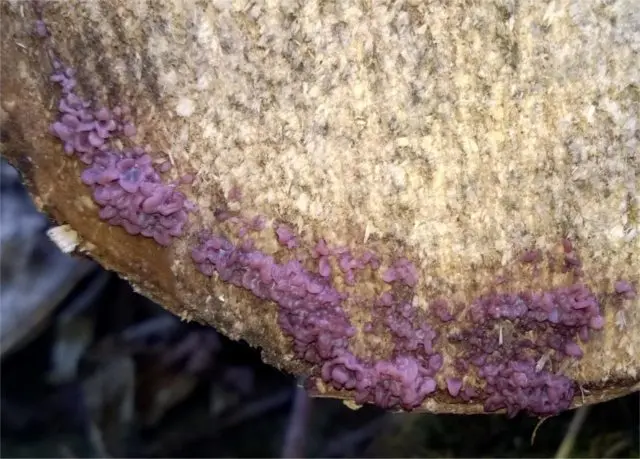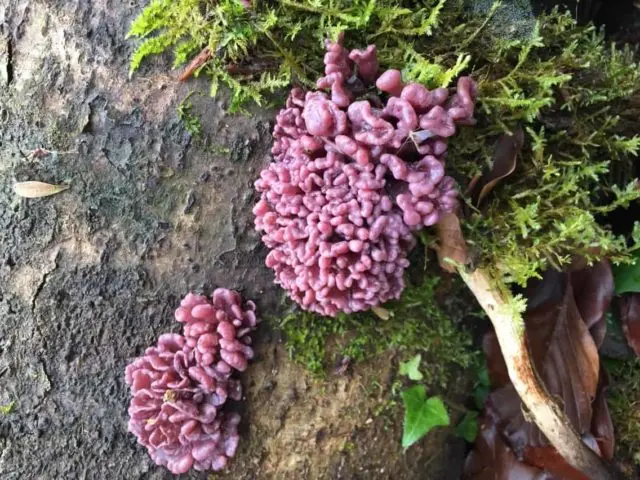Contents
Meat ascocorine, or corine, is a species of the Gelocian family, whose representatives are numerous and are characterized for the most part by small or microscopic organisms. In mycology the fungus is known as Ascocoryne or Coryne, sarcoides, Bulgaria or Chlorospleniella or Sarcodea sarcoides, Helvella purpurea or sarcoides.
In addition to these names, there are other, less common, definitions of meat coryne in Latin: Ombrophila, or Lichen, or Octospora, or Tremella sarcoides, Peziza porphyria, or tremelloidea, or sarcoides.
Many ascomycetes, or marsupials, of the family, like this species, feed on dead wood.

Outwardly, colonies of ascocorine meat are bright, although small growths on dead wood
Where does ascocorine meat grow?
Tree marsupials of the species are most often found in clusters, where one fruiting body is closely pressed against another and deformed because of this. Colonies of ascocorina meat are always found on old rotten hardwood, especially on birch:
- on rotten logs;
- fallen trunks;
- tree stump
Settlements are large. Their size is explained by the method of reproduction with the help of conidia, processes from the fruiting body, which are immobile spores due to indirect cell division. Very rarely found solitary mushrooms. Ascocorine meat colonies form from late summer to early winter. In regions with mild winters, the fruiting bodies of the species develop during the cold period, and are also found at the end of February. Korine meat is distributed in areas with temperate climatic conditions throughout Eurasia, as well as in North America.
What does meat ascocorine look like?
One fruiting body develops from a lobed or spherical initial shape to formations that look like a flat bowl or funnel. Miniature sizes:
- diameter up to 10 mm;
- height from 6 to 12 mm.
There is no cap as such in the fruiting body of the meat species. The fungus is on a short false stalk that feeds on the substrate. The color of the skin and flesh is pink-violet, it can be reddish or gray-lilac, resembling minced meat. The outer surface of the fruiting body is slightly hairy. Inside – smooth or slightly folded. The color is the same on both sides.
Askokorina meat goes through two phases of development. First, tongue-shaped conidia can form on the fruiting body, no longer than 1 cm in size, which in ascomycetes serve for asexual budding. Over time, under favorable conditions, new mushroom bodies are created from conidia, thus forming medium-sized colonies of a meat type.
At the second stage of development, mushrooms turn into saucers – up to 3 cm. Prominent clusters are quite extensive in area. The pulp is gel-like, odorless. With age, the colony becomes more and more vague and gelatinous. The outlines of the edges of individual mushrooms are lost, which merge with each other, turning into a shapeless mass while maintaining a pink-purple hue. The mass of spores is white.

As the fruiting bodies in clusters crawl over each other, deform, becoming a brain-shaped flat formation of a pink-red hue
Is it possible to eat ascocorine meat
The mushroom is considered inedible both because of the extremely small volume of fruiting bodies, and because of the insufficiently studied properties of the pulp. In addition, accumulations on old wood, painted in lilac-pink, have an unpleasant texture and unattractive appearance. The results of recent studies have concluded that there are no toxic substances in the meat ascocoryne pulp, as well as in the fruiting bodies of the twin – Ascocoryne cylichnium (Ascocoryne cylichnium). These tree mushrooms are very similar, they can only be distinguished by experts at the microscopic level.

Ascocorine cilichnium, or goblet, is the same small formation on rotting wood
There is information from some sources that when studying meat corine about 10 years ago, they found out interesting facts about the properties of the species:
- volatile substances are formed in the pulp, which they called “mycodiesel”, since they resemble automobile fuel in terms of the content of octane, carbon alcohols and ketones;
- about the detection of an antibiotic in the pulp, which has an overwhelming effect on gram-positive bacteria.
Conclusion
Ascocorine meat is a rather rare tree fungus of the temperate climate zone. The small, brightly colored fruiting bodies of the species are not of any culinary interest, although they are not poisonous.









